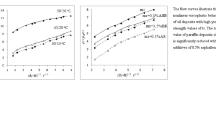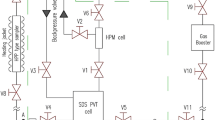Crude-oil transportation requires a study of the latent heat of phase transitions and the melting parameters of solid paraffin in the oil. The latent heat of fusion and the effect of the heating rate on melting were measured for Daqing oilfield waxy oil using differential scanning calorimetry. The peak melting ranges of the waxes were determined. The results showed that the total latent heats at heating rate 5°C/min from —20°C to the end of melting were 3035 and 39.26 J/g for two crude-oil samples. The latent heat maximum temperatures were 24.5 and 25.5°C The maximum latent heat for both samples was attained at heating rate 1°C/min. The relative deviation for the other heating rates was less than 3%. It was shown that the heating rate affected the position of the latent heat peak. The peak temperature shifted from 24 to 28°C for one sample and from 25.5 to 28.0°C for the other as the heating rate increased from I to 15°C/min. The results of the present work could be useful for further research on the paraffin precipitation mechanism during transportation of crude oil.
Similar content being viewed by others
Explore related subjects
Discover the latest articles, news and stories from top researchers in related subjects.Avoid common mistakes on your manuscript.
Low-permeability oilfields with recovery of <3 t/d must be developed because of the increasing economic demand for oil. Annular gathering and transportation of oil mixed with hot water are widely used to reduce production costs and energy consumption [1, 2]. The temperature of waxy crude oil at the well head for oilfields of the Daqing type, i.e., extremely cold, was shown to be significantly below the gel point, which could cause clogging of pipelines, increased pressures in well-head equipment, and increased energy consumption [3]. Rapid heating of oil by hot water was proposed to provide technologically safe transportation of oil. It is now essential to determine the latent beat of fusion and the relative content of crystalline waxes in the crude oil.
Crystallization in oil has been well studied. The thermal behavior of heavy crude from Brazilian oilfields was studied using differential scanning calorimetry (DSC). The peak temperature and latent heat of fusion were determined [4]. Endotherm temperature ranges were measured for crude oil and TotalFinaElf blends using DSC [5]. The heating—cooling characteristics of water—oil emulsions of Mexican heavy oil were studied to formulate an equation for the dependence of the crystallization temperature on the size distribution of water drops in the emulsion [6]. However, the latent heat and relative content of waxy crystals in oil are poorly studied and measured.
Melting in crude oil has several peculiarities. First, crude oil is a multicomponent mixture of compounds with various melting points. Second, crude oil remains fluid at a temperature 3°C above the gel point [7]. Considering this, it can be seen that all oil components do not have to melt to ensure mobility. The optimal oil mobility can be estimated from the latent heat of fusion and the relative content of waxy crystals involved in the melting.
The present work focused on melting of waxy crystals in crude-oil samples from Daqing oilfield. The peak melting range was determined from calorimetric curves. The resulting latent heats and relative component contents allowed the effect of heating rate on the melting parameters to be proposed.
Crude-oil samples from two regions of Daqing oilfield (Nos. 1 and 2) were investigated. The water contents, gel points, and calorimetry curves were determined for the two samples. The gel points for samples Nos. 1 and 2 were 36 and 38°C, respectively. The water content measured by distillation was 0.075% for sample No. 1; 0.100%, No. 2. The water content of <0.5% for both samples met the requirement for application of DSC.
The samples were studied on a DSC instrument. The total latent heat, heat of fusion, and percent content of components were measured over a given temperature range. Samples were placed into an aluminum pan (5.80 g) and scanned in the range -40 to 70°C at various heating rates (1. 2, 5, 8, 10, and 15°Cmin). The accuracy of the instrument measurement was 0.01°C in temperature and 0.1% in calorimetry.
Baselines of calorimetry curves of crude-oil crystallization can be chosen in two ways, i.e., reverse extended line and interpolation [8, 9]. The extended line is used for linear DSC sections above the start of crystallization. The baseline for interpolation is drawn between the crystallization point and a point at -20°C. The baseline interpolation method can produce the crystal contents in crude oil [10] and calculate the latent heat of fusion.
The total heat of fusion of waxy crystals can be written
where Hm is the total latent heat of fusion from —20°C to tend; dQm, absorbed heat on changing the temperature from t to t+ dt; km, heating rate; dS, area on the plot between the DSC curve and the interpolated baseline in the range from t to t + dt.
The waxy crystal melting peak could be determined as the temperature range in which the latent heat was equal to or greater than the average latent heat adjusted to °C. The average latent heat could be written
where ΔT = tend – (−20)°C.
The relative content in the crude oil of waxy crystals involved in the melting could be written
where \( {\overline{Q}}_m \), is the heat of fusion of waxy crystals (220 J/g).
The content of waxy crystals at this temperature was written
where t is the given melting point; dQ, change of latent heat for temperature change dt.
Figure 1 shows DSC curves for the two samples at heating rate 5°C/min. It can be seen that the curves for samples No. 1 and 2 were of the same nature. The curve for each sample had two endothermic peaks corresponding to two main melting stages, i.e., peaks at 24.5 and 25.5°C and at 46.1 and 45.4°C for samples No. 1 and 2, respectively. Thus, two stages can be identified during crystallization of crude oil, i.e., formation of crystallization nuclei and the start of crystal precipitation. The peak temperatures were different for the different samples.
Figure 2 shows the interpolated baselines. A temperature of −20°C, at which crude-oil crystallization ended, was selected as the beginning of the line. The end point for the calculations (or the right baseline boundary) (tend) corresponded to the end of melting. The end point in the present work corresponded to the temperature at which the heat flow did not change, i.e., the change of flow on the curve at point tend was less than 0.0001 W/g for a temperature rise of 1°C.
Figure 3 shows plots of the integrated heat. The integrated heat was observed to be negative, i.e., the fusion was endothermic. The absolute value of the integrated heat increased sharply in the range 0-40°C, which corresponded to the peak in Fig. 1. The total latent heats for samples No. 1 and 2 at heating rate 5°C/min were −30.35 and −39.26 J/g. respectively. The latent heat for any temperature can be calculated using Eq. (2). Figure 4a shows the calculated latent heats in steps of 1°C. For example, the heat for sample No. 1 at 19.5°C is −0.7503 J/g. i.e., the sample absorbed 0.7503 J/g as the temperature changed from 19 to 20°C. The plots for both samples had two distinct asymmetric peaks because the proportion of crude-oil components was different for each temperature range. The maximum latent heats for No. 1 and 2 were 0.7851 and 1.0983 J/g at 24.5 and 25.5°C, respectively.
The fraction of crystals involved in melting at a given temperature was calculated using Eq. (5). Figure 4b shows the results in steps of dt = 1°C. It can be seen that the maximum fraction of crystals involved in melting for samples No. 1 and 2 were 0.36 and 0.5% at 24.5 and 25.5°C, respectively. Melting of waxy crystals and a crude-oil sample could in general be qualitatively characterized by the fraction of crystals involved in melting at the given temperature. The parameters of the peak melting ranges of the waxes could be calculated using the plot in Fig. 4a and Eq. (3). Table 1 presents the results.
The preceding DSC data were taken at heating rate 5°C/min. However, the effect of heating rate on process characteristics such as the enthalpy of fusion, maximum latent heat, and paraffin precipitation temperature had to be studied in order to understand the melting process and to determine the optimal parameters [11]. The effect of heating rate on the calorimetry cams was studied at 1, 2, 5, 8, 10, and 15°C/min. Figure 5 shows the results. The characteristic bend of the DSC curves decreased as the heating rate decreased.
Obviously, the shapes of the plots and the peak temperatures depended dearly on the heating rate. Table 2 presents data for the DSC curves. The results indicated that TP and Hm. varied as the heating rate changed from 1 to 15°C/min. The maximum latent heat of fusion for samples No. 1 and 2 corresponded to 1°C/min. The relative error for the other heating rates was less than 3%. The peak temperature changed from 24 to 28°C for sample No. 1; from 25.5 to 28.0°C, sample No. 2.
References
Y. Liu, Z. Wang, X. Zhuge, et al., Chem. Technol. Fuels Oil, No. 5,386-392 (2012).
R. Zhang, P. H. Winterfeld, X. Yin, et al., J. Nat. Gas Sci Eng., No. 27, 579-615 (2015).
X. Liu, W. Chen, Y. Zhao, et al., J. Therm. Sci. Technol, No. 4,347-351 (2012) (in Chinese).
M. G. Motha, C. G Motha, and C. H. M. de Carvalho, J. Therm. Anal. Calorim., No. 2, 525-531(2012).
G Ekulu, C. Nicolas, C. Achard, et al., Energy Fuels, No. 4, 1297-1302 (2005).
A. D. Javier, A. F. Eugenio, L. Alfonso, et al., J. Therm. Anal. Calorim., No. 4, 899-906 (2010).
Z. Wang, R. Pang, X. Le, et al., J. Pet. Sci. Eng., No. 111, 178-183 (2013).
J. Chen, J. Zhang, and H. Li, Thermochim. Acta, No. 1,23-26 (2004).
S. Kumar, S. P. Nautiyal, H. U. Khan, et al., Pet. Sci. Technol., No. 7-8, 939-951(2005).
X. Liu, Z. Wang, L. Liu, et al., Adv. Mech. Eng., No. 2014, 1-11(2014).
E. M. Anghel, A. Georgiev, S. Petrescu, et a1., J Therm. Anal. Calorim., No. 2, 557-566 (2014).
Acknowledgments
The work was financially supported by the Natural Science Foundation of Heilongjiang Province (No. Zd2015011) and a State Program of the Chinese National Natural Science Foundation (No. 515334004).
Author information
Authors and Affiliations
Corresponding author
Additional information
Translated from Khimiya i Tekhnologiya Topliv i Masel, No. 4, pp. 32 – 35, July – August, 2018.
Rights and permissions
About this article
Cite this article
Liu, X., Cui, X., Wang, Z. et al. Effect of Heating Rate on Latent Heat of Fusion of Waxy Crystals in Crude Oil. Chem Technol Fuels Oils 54, 438–445 (2018). https://doi.org/10.1007/s10553-018-0945-4
Published:
Issue Date:
DOI: https://doi.org/10.1007/s10553-018-0945-4









